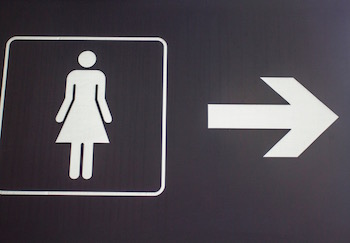
If you feel like your bladder is in the driver’s seat — forcing you to take detours to the bathroom multiple times during the day and night — you’re not alone. As many as 40 percent of women in the U.S. live with the symptoms of overactive bladder (OAB), according to the Urology Care Foundation. However, that estimate only includes those who report their symptoms — the true count is likely much higher.
“Overactive bladder is actually more common than many realize,” says urogynecologist Elisa Trowbridge, division director for the Women’s Center for Continence and Pelvic Surgery. “Fortunately, there’s a lot we can do now to correct the problem, so women no longer have to just learn to live with it.”
Is It Overactive Bladder?
OAB or urge incontinence causes the sensation of urgency so that women feel the need to urinate more frequently, often in excess of eight times per day. The cause: errant signals from the nerves to the bladder that force it to contract.
“Urge incontinence or overactive bladder (OAB) results from the bladder receiving signals at the wrong time, thus causing an uncontrollable spasm that can lead to urine leakage, a strong urge to empty the bladder or frequent urination” says Trowbridge. Caffeine intake and excessive fluid consumption increase urine production, which worsens these errant signals, she adds.
Some women (approximately 50 percent) may benefit from medication and lifestyle changes. Others may be candidates for a fairly new alternative: Botox® injections.
Recent studies suggest that Botox injections into the bladder are safe and effective, so doctors may consider this treatment option soon after an initial medication therapy has failed. The American Urogynecologic Society (AUGS) and the American Congress of Obstetricians and Gynecologists (ACOG) have recommended that Botox injections may be an appropriate second-line therapy option.
How Botox Treatment Works
Our team can perform the Botox procedure either as an office procedure in the clinic or in the outpatient surgical center, under mild sedation. It takes about 10 to 20 minutes to complete. There is minimal pain associated with the procedure. However, there may be slight burning sensation with the first void after the procedure.
Doctors:
1. Perform a cystoscopy (where they enter the bladder through the urethra with a lighted tube).
2. Partially fill the bladder with saline
3. Administer about 10 injections into the dome of the bladder.
4. Empty the bladder.
Patients will need to take antibiotics for the next three days following the procedure.
In studies, 18 percent of patients developed a UTI after the procedure, which is why doctors recommend antibiotics. Additionally, in about six percent of cases, patients initially have trouble emptying their bladders completely and will need to use a catheter for seven to ten days after the procedure.
Overactive Bladder Symptoms?
Make an appointment with a urogynecologist.
Botox loses its effect after about six months, but the procedure can be repeated twice a year as necessary. Medicare and other major insurers cover Botox for incontinence if medication has been ineffective.
Who Is Eligible for Botox Treatment?
Women who are good candidates for Botox treatment include those who:
- Tried multiple medications unsuccessfully
- Have not found relief with lifestyle modifications
- Have urinary urgency and frequency (more than 10 voids per day), as well as urinary leakage associated with urgency
“These are women who have to go to the bathroom all the time, day and night, and nothing works for them,” says Trowbridge. For patients like these, she adds, Botox has been “a game changer.”
On the flip side, doctors don’t recommend Botox treatment for women with chronic urinary tract infections or who have trouble completely emptying the bladder.


Can Bladder Botox inadvertently cause constipation as a side effect?
I am very impressed by your site and your post is very nice and I got such a piece of good information on this topic it’s a very interesting one.